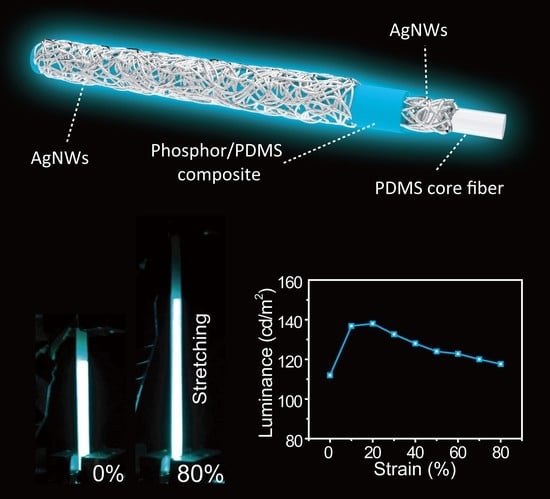A Stretchable Alternating Current Electroluminescent Fiber
Abstract
:1. Introduction
2. Results and Discussion
3. Materials and Methods
3.1. PDMS Fiber Fabrication
3.2. Stretchable EL Fiber Fabrication
3.3. Device Characterization
4. Conclusions
Acknowledgments
Author Contributions
Conflicts of Interest
References
- Wang, J.X.; Yan, C.Y.; Chee, K.J.; Lee, P.S. Highly stretchable and self-deformable alternating current electroluminescent devices. Adv. Mater. 2015, 27, 2876–2882. [Google Scholar] [CrossRef] [PubMed]
- Qian, Y.; Zhang, X.; Xie, L.; Qi, D.; Chandran, B.K.; Chen, X.; Huang, W. Stretchable organic semiconductor devices. Adv. Mater. 2016, 28, 9243–9265. [Google Scholar] [CrossRef] [PubMed]
- Bade, S.G.R.; Shan, X.; Phong Tran, H.; Li, J.; Geske, T.; Cai, L.; Pei, Q.; Wang, C.; Yu, Z. Stretchable light-emitting diodes with organometal-halide-perovskite-polymer composite emitters. Adv. Mater. 2017, 29. [Google Scholar] [CrossRef] [PubMed]
- Yu, Z.; Niu, X.; Liu, Z.; Pei, Q. Intrinsically stretchable polymer light-emitting devices using carbon nanotube-polymer composite electrodes. Adv. Mater. 2011, 23, 3989–3994. [Google Scholar] [CrossRef] [PubMed]
- Yang, C.H.; Chen, B.H.; Zhou, J.X.; Chen, Y.M.; Suo, Z.G. Electroluminescence of giant stretchability. Adv. Mater. 2016, 28, 4480–4484. [Google Scholar] [CrossRef] [PubMed]
- Stauffer, F.; Tybrandt, K. Bright stretchable alternating current electroluminescent displays based on high permittivity composites. Adv. Mater. 2016, 28, 7200–7203. [Google Scholar] [CrossRef] [PubMed]
- Sekitani, T.; Nakajima, H.; Maeda, H.; Fukushima, T.; Aida, T.; Hata, K.; Someya, T. Stretchable active-matrix organic light-emitting diode display using printable elastic conductors. Nat. Mater. 2009, 8, 494–499. [Google Scholar] [CrossRef] [PubMed]
- White, M.S.; Kaltenbrunner, M.; Glowacki, E.D.; Gutnichenko, K.; Kettlgruber, G.; Graz, I.; Aazou, S.; Ulbricht, C.; Egbe, D.A.M.; Miron, M.C.; et al. Ultrathin, highly flexible and stretchable pleds. Nat. Photonics 2013, 7, 811–816. [Google Scholar] [CrossRef]
- Zhang, Z.; Zhang, Q.; Guo, K.; Li, Y.; Li, X.; Wang, L.; Luo, Y.; Li, H.; Zhang, Y.; Guan, G. Flexible electroluminescent fiber fabricated from coaxially wound carbon nanotube sheets. J. Mater. Chem. C 2015, 3, 5621–5624. [Google Scholar] [CrossRef]
- Park, S.-I.; Xiong, Y.; Kim, R.-H.; Elvikis, P.; Meitl, M.; Kim, D.-H.; Wu, J.; Yoon, J.; Yu, C.-J.; Liu, Z.; et al. Printed assemblies of inorganic light-emitting diodes for deformable and semitransparent displays. Science 2009, 325, 977–981. [Google Scholar] [CrossRef] [PubMed]
- Wang, J.; Lee, P.S. Progress and prospects in stretchable electroluminescent devices. Nanophotonics 2017, 6, 435–451. [Google Scholar] [CrossRef]
- Tran Quang, T.; Lee, N.-E. Recent progress on stretchable electronic devices with intrinsically stretchable components. Adv. Mater. 2017, 29. [Google Scholar] [CrossRef]
- Wang, J.X.; Yan, C.Y.; Cai, G.F.; Cui, M.Q.; Eh, A.L.S.; Lee, P.S. Extremely stretchable electroluminescent devices with ionic conductors. Adv. Mater. 2016, 28, 4490–4496. [Google Scholar] [CrossRef] [PubMed]
- Larson, C.; Peele, B.; Li, S.; Robinson, S.; Totaro, M.; Beccai, L.; Mazzolai, B.; Shepherd, R. Highly stretchable electroluminescent skin for optical signaling and tactile sensing. Science 2016, 351, 1071–1074. [Google Scholar] [CrossRef] [PubMed]
- Yang, Z.; Deng, J.; Chen, X.; Ren, J.; Peng, H. A highly stretchable, fiber-shaped supercapacitor. Angew. Chem. Int. Ed. 2013, 52, 13453–13457. [Google Scholar] [CrossRef] [PubMed]
- Zhang, Z.; Yang, Z.; Deng, J.; Zhang, Y.; Guan, G.; Peng, H. Stretchable polymer solar cell fibers. Small 2015, 11, 675–680. [Google Scholar] [CrossRef] [PubMed]
- He, X.; Zi, Y.; Guo, H.; Zheng, H.; Xi, Y.; Wu, C.; Wang, J.; Zhang, W.; Lu, C.; Wang, Z.L. A highly stretchable fiber-based triboelectric nanogenerator for self-powered wearable electronics. Adv. Funct. Mater. 2017, 27. [Google Scholar] [CrossRef]
- Guan, L.; Nilghaz, A.; Su, B.; Jiang, L.; Cheng, W.; Shen, W. Stretchable-fiber-confined wetting conductive liquids as wearable human health monitors. Adv. Funct. Mater. 2016, 26, 4511–4517. [Google Scholar] [CrossRef]
- Liu, Z.F.; Fang, S.; Moura, F.A.; Ding, J.N.; Jiang, N.; Di, J.; Zhang, M.; Lepro, X.; Galvao, D.S.; Haines, C.S.; et al. Hierarchically buckled sheath-core fibers for superelastic electronics, sensors, and muscles. Science 2015, 349, 400–404. [Google Scholar] [CrossRef] [PubMed]
- Zhang, Z.; Li, X.; Guan, G.; Pan, S.; Zhu, Z.; Ren, D.; Peng, H. A lightweight polymer solar cell textile that functions when illuminated from either side. Angew. Chem. Int. Ed. 2014, 53, 11571–11574. [Google Scholar] [CrossRef] [PubMed]
- Xu, F.; Zhu, Y. Highly conductive and stretchable silver nanowire conductors. Adv. Mater. 2012, 24, 5117–5122. [Google Scholar] [CrossRef] [PubMed]
- Amjadi, M.; Pichitpajongkit, A.; Lee, S.; Ryu, S.; Park, I. Highly stretchable and sensitive strain sensor based on silver nanowire-elastomer nanocomposite. ACS Nano 2014, 8, 5154–5163. [Google Scholar] [CrossRef] [PubMed]
- Hu, L.; Kim, H.S.; Lee, J.-Y.; Peumans, P.; Cui, Y. Scalable coating and properties of transparent, flexible, silver nanowire electrodes. ACS Nano 2010, 4, 2955–2963. [Google Scholar] [CrossRef] [PubMed]
- Van de Groep, J.; Spinelli, P.; Polman, A. Transparent conducting silver nanowire networks. Nano Lett. 2012, 12, 3138–3144. [Google Scholar] [CrossRef] [PubMed]
- Vak, D.; Kim, S.-S.; Jo, J.; Oh, S.-H.; Na, S.-I.; Kim, J.; Kim, D.-Y. Fabrication of organic bulk heterojunction solar cells by a spray deposition method for low-cost power generation. Appl. Phys. Lett. 2007, 91. [Google Scholar] [CrossRef]
- Park, S.-Y.; Kang, Y.-J.; Lee, S.; Kim, D.-G.; Kim, J.-K.; Kim, J.H.; Kang, J.-W. Spray-coated organic solar cells with large-area of 12.25 cm(2). Sol. Energy Mater. Sol. Cells 2011, 95, 852–855. [Google Scholar] [CrossRef]
- Xu, X.; Hu, D.; Yan, L.; Fang, S.; Shen, C.; Loo, Y.L.; Lin, Y.; Haines, C.S.; Li, N.; Zakhidov, A.A. Polar-electrode-bridged electroluminescent displays: 2D sensors remotely communicating optically. Adv. Mater. 2017, 29, 1703552. [Google Scholar] [CrossRef] [PubMed]
- Allieri, B.; Peruzzi, S.; Antonini, L.; Speghini, A.; Bettinelli, M.; Consolini, D.; Dotti, G.; Depero, L.E. Spectroscopic characterisation of alternate current electroluminescent devices based on zns-cu. J. Alloys Compd. 2002, 341, 79–81. [Google Scholar] [CrossRef]
- Ibafiez, J.; Garcia, E.; Gil, L.; Mollar, M.; Mari, B. Frequency-dependent light emission and extinction of electrolumine scent zns: Cu phosphor. Displays 2007, 28, 112–117. [Google Scholar]
- Huang, J.M.; Yang, Y.; Xue, S.H.; Yang, B.; Liu, S.Y.; Shen, J.C. Photoluminescence and electroluminescence of ZnS:Cu nanocrystals in polymeric networks. Appl. Phys. Lett. 1997, 70, 2335–2337. [Google Scholar] [CrossRef]
- Zhang, Z.; Guo, K.; Li, Y.; Li, X.; Guan, G.; Li, H.; Luo, Y.; Zhao, F.; Zhang, Q.; Wei, B.; et al. A colour-tunable, weavable fibre-shaped polymer light-emitting electrochemical cell. Nat. Photonics 2015, 9, 233–238. [Google Scholar] [CrossRef]
- Kwon, S.; Kim, W.; Kim, H.; Choi, S.; Park, B.-C.; Kang, S.-H.; Choi, K.C. High luminance fiber-based polymer light-emitting devices by a dip-coating method. Adv. Electron. Mater. 2015, 1. [Google Scholar] [CrossRef]
- O’Connor, B.; An, K.H.; Zhao, Y.; Pipe, K.P.; Shtein, M. Fiber shaped light emitting device. Adv. Mater. 2010, 19, 3897–3900. [Google Scholar] [CrossRef]
- Vohra, V.; Giovanella, U.; Tubino, R.; Murata, H.; Botta, C. Electroluminescence from conjugated polymer electrospun nanofibers in solution processable organic light-emitting diodes. ACS Nano 2011, 5, 5572–5578. [Google Scholar] [CrossRef] [PubMed]
- Yang, H.; Lightner, C.R.; Dong, L. Light-emitting coaxial nanofibers. ACS Nano 2012, 6, 622–628. [Google Scholar] [CrossRef] [PubMed]
- Park, H.; Noh, S.H.; Lee, J.H.; Lee, W.J.; Jaung, J.Y.; Lee, S.G.; Han, T.H. Large scale synthesis and light emitting fibers of tailor-made graphene quantum dots. Sci. Rep. 2015, 5, 14163. [Google Scholar] [CrossRef] [PubMed]
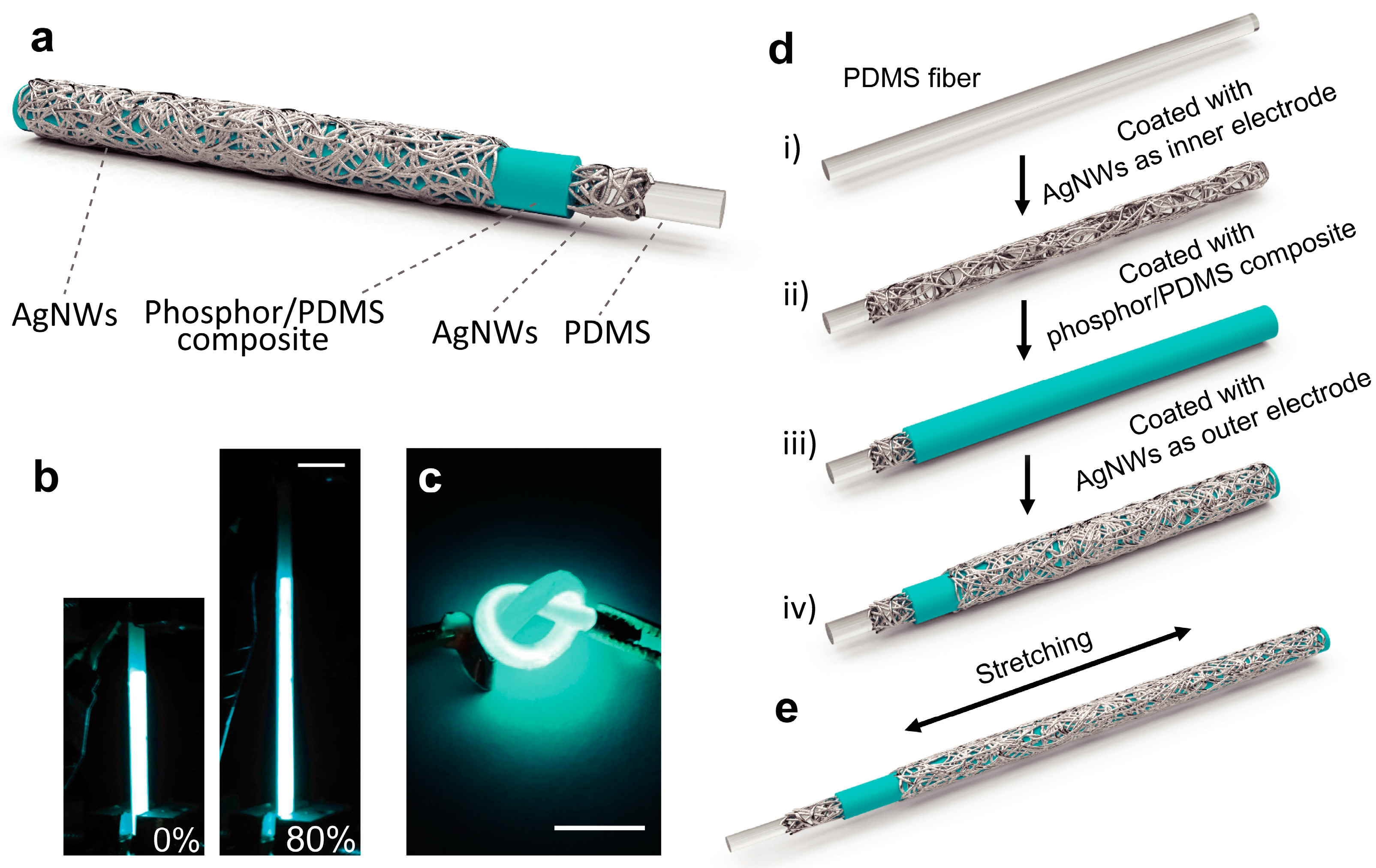
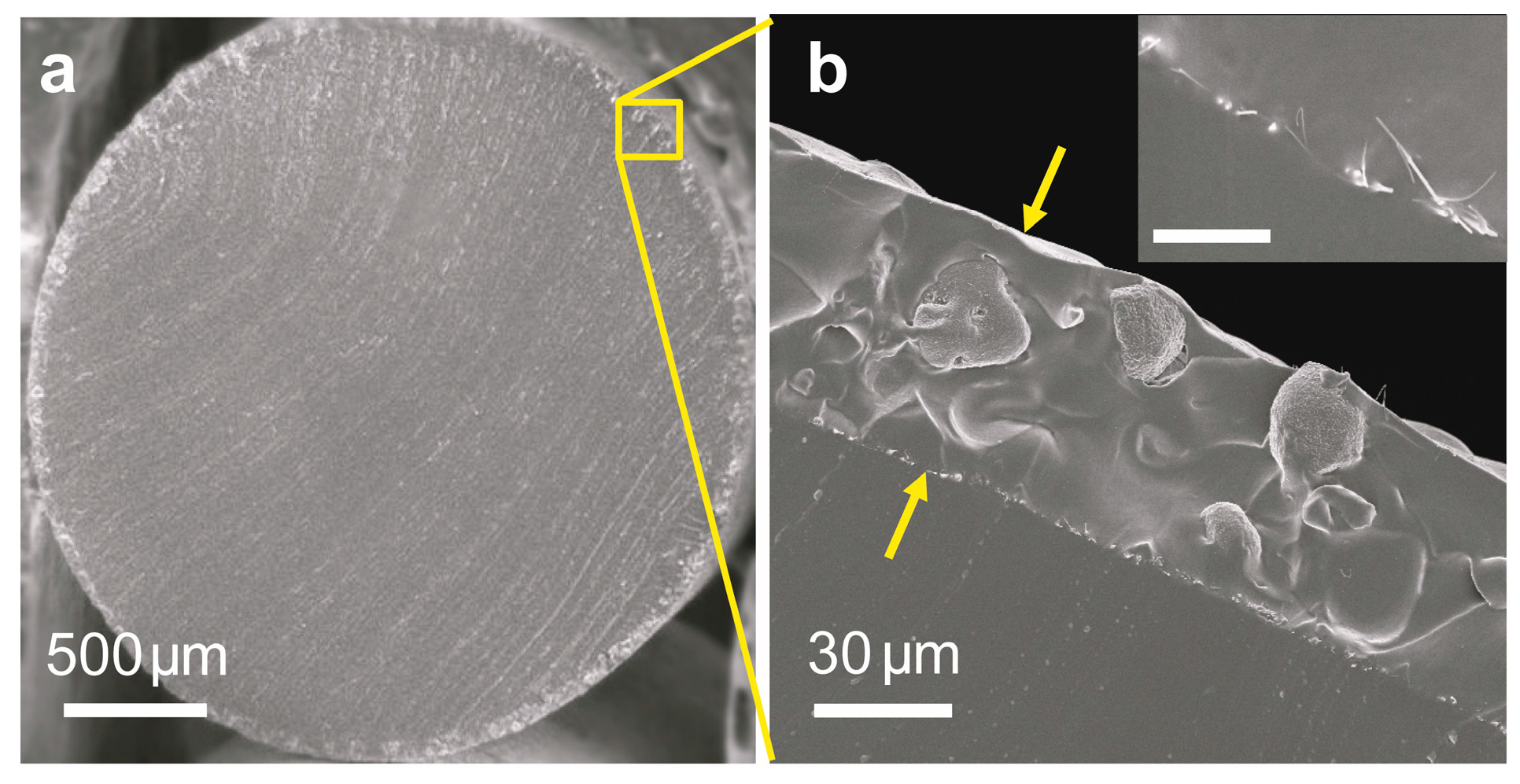
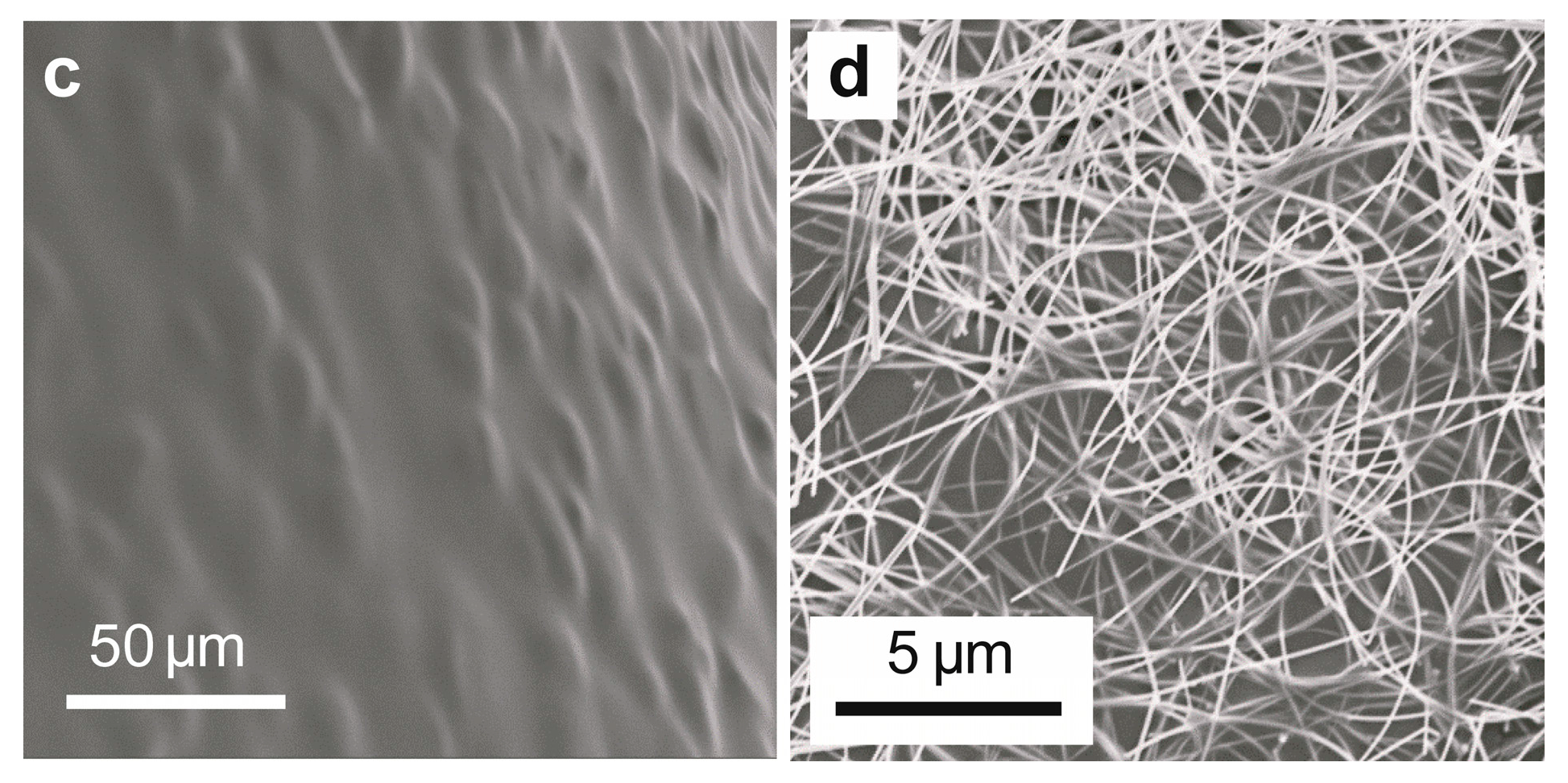
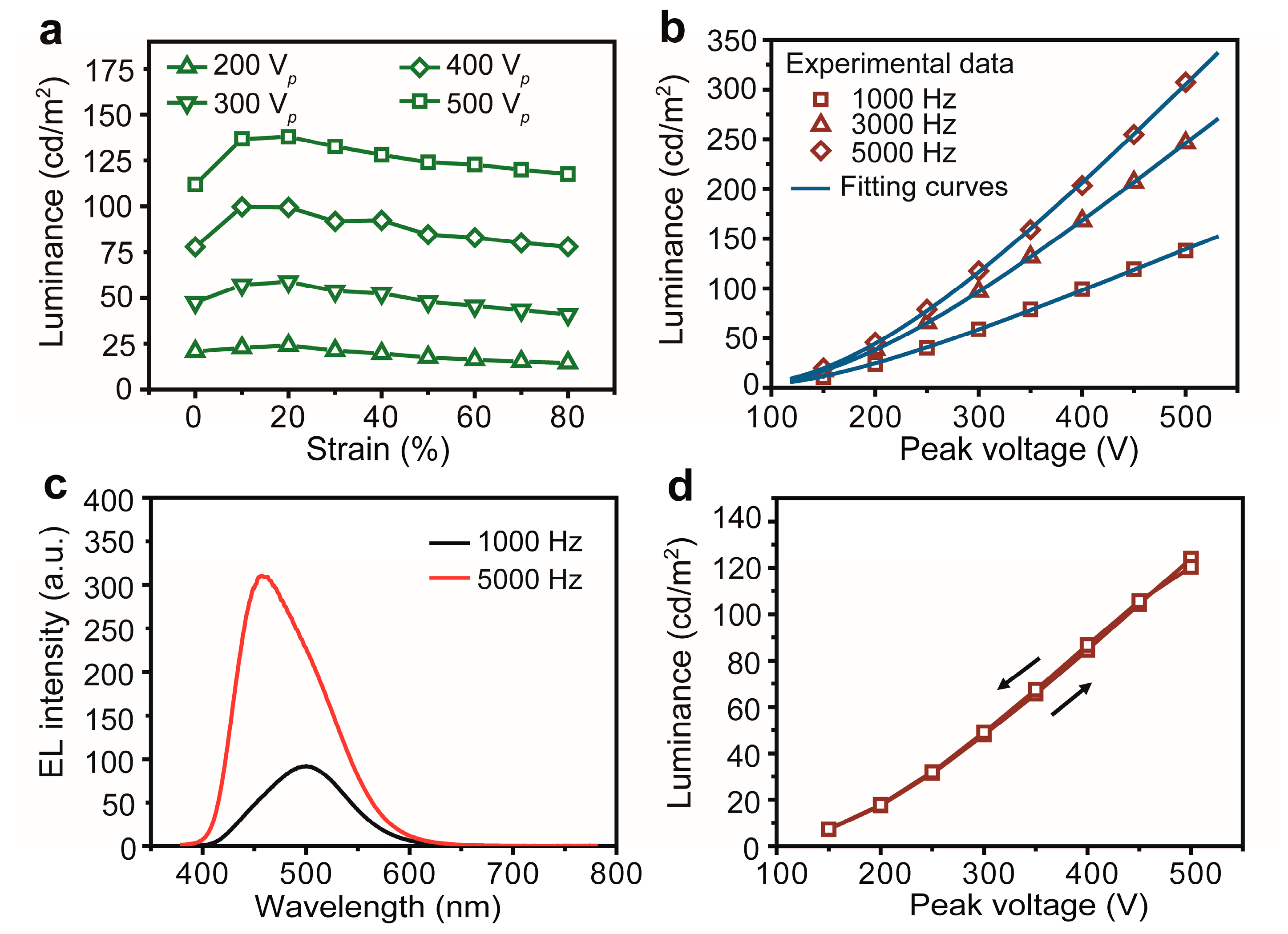
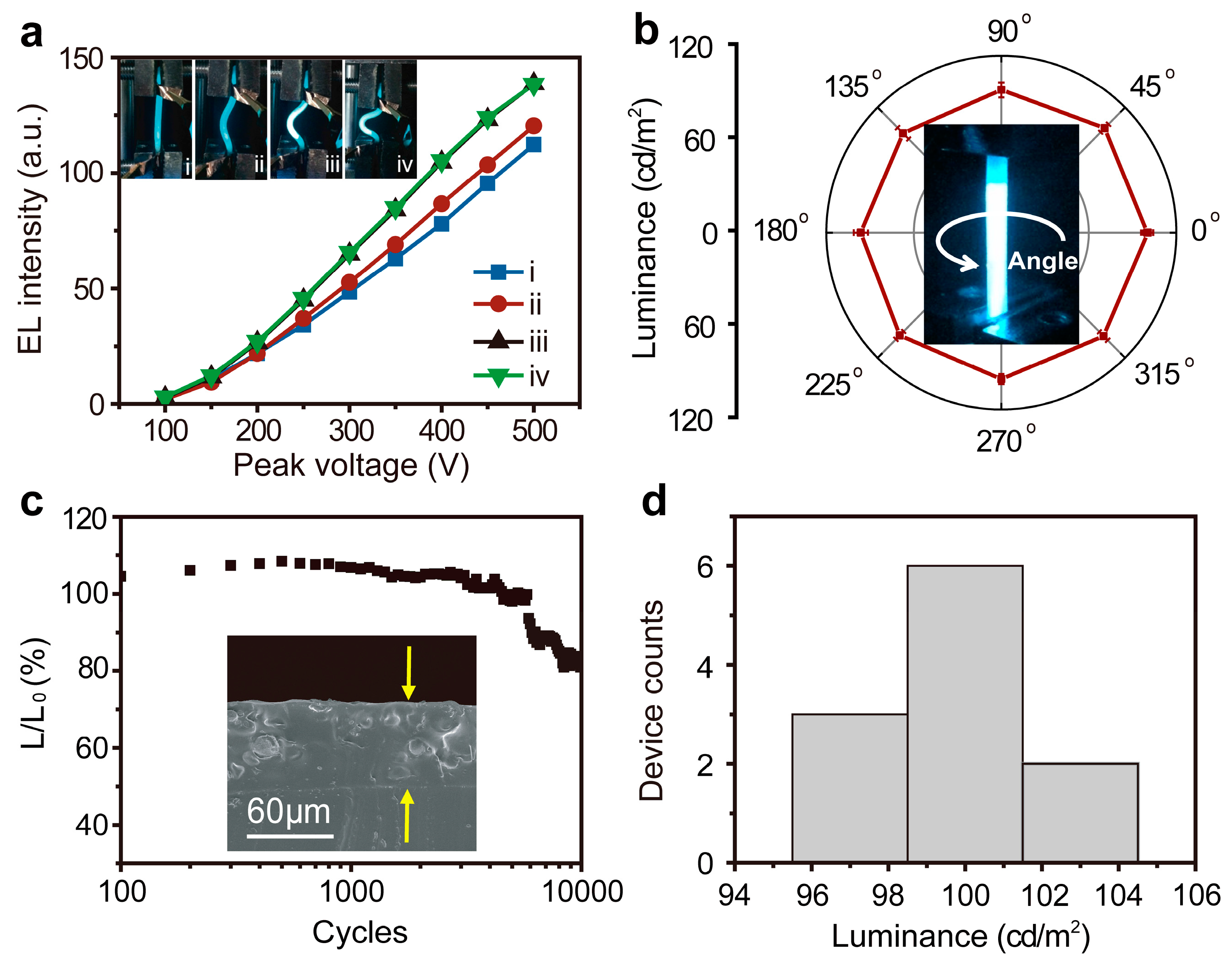
| Light-Emitting Layer | Inner/Outer Electrode | Max Luminance (cd/m2) | Max Strain (%) | Stretching Cycles | Viewing Angle (°) | ||
|---|---|---|---|---|---|---|---|
| Materials | Method | Materials | Method | ||||
| PF-B [31] | dip-coating | aligned CNT/aligned CNT | mechanically wrapping/mechanically wrapping | 609 (13 V) | 0 | --- | 180 |
| Superyellow [32] | dip-coating | PEDOT:PSS/Al/LiF | dip-coating/evaporation | 1458.8 (10 V) | 0 | --- | --- |
| α-NPD [33] | evaporation | Al/Al | evaporation/evaporation | --- | 0 | --- | --- |
| F8BT [34] | ES a) | liquid metal/ITO | coaxial ES/evaporation/evaporation | 2300 (6 V) | 0 | --- | --- |
| [Ru(bpy)3]2+ (PF6−)2 [35] | ES | ITO/Ca/Al | evaporation/evaporation | --- | 0 | --- | --- |
| Graphene QD [36] | drop-casting | --- | --- | --- | 0 | --- | --- |
| ZnS:Cu/PDMS b) | dip-coating | AgNWs/AgNWs | spray-coating/spray-coating | 307.3 (500 Vp, 5 kHz) | 80 | 6000 | 360 |
© 2018 by the authors. Licensee MDPI, Basel, Switzerland. This article is an open access article distributed under the terms and conditions of the Creative Commons Attribution (CC BY) license (http://creativecommons.org/licenses/by/4.0/).
Share and Cite
Hu, D.; Xu, X.; Miao, J.; Gidron, O.; Meng, H. A Stretchable Alternating Current Electroluminescent Fiber. Materials 2018, 11, 184. https://doi.org/10.3390/ma11020184
Hu D, Xu X, Miao J, Gidron O, Meng H. A Stretchable Alternating Current Electroluminescent Fiber. Materials. 2018; 11(2):184. https://doi.org/10.3390/ma11020184
Chicago/Turabian StyleHu, Dan, Xiuru Xu, Jingsheng Miao, Ori Gidron, and Hong Meng. 2018. "A Stretchable Alternating Current Electroluminescent Fiber" Materials 11, no. 2: 184. https://doi.org/10.3390/ma11020184




